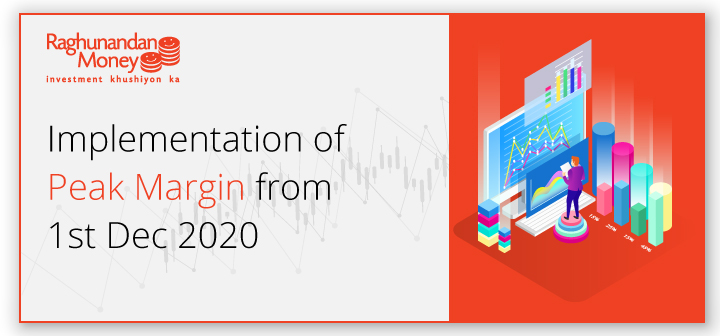
Search for an answer or browse help topics
Post Date : April 25, 2022

From December 1, 2020, the concept of peak margin reporting will be introduced. This will have a big impact on the intraday margin/limit that customers enjoy currently along with other changes. In this article, we shall first explain what the concept of peak margin means, and then examine how the Securities and Exchange Board of India’s (Sebi) new rules (introduced through circular dated July 20, 2020) will impact stock market participants.
The concept of peak margin will apply to all segments – cash, futures and options, and commodities. However, since 90 percent of the trading in the market happens in derivatives, the impact will be the highest there.
Peak Margin Requirement
Until now, the reporting for margin requirements happened on the basis of end-of-day positions, or the positions that a client carries forward to the next day. Based on these positions, the exchange imposes a margin on the customer. Under peak margin reporting, however, four snapshots of a client’s positions will be taken across the day. The highest of these positions will be taken to calculate his peak margin requirement for the day. Henceforth, the end-of-the-day margin will also be applicable and the peak margin will also be applicable. If the peak margin requirement is higher than the end-of-day margin requirement, the former will prevail.
Often, brokers promise their customers high leverage of say 50 times. This allows customers to deposit an amount of just Rs. 1 lakh and purchase securities worth Rs. 50 lakh intra-day. At the end of the day, however, they square off all their positions or carry forward only limited positions, so that the Rs. 1 lakh in their account suffices to meet their margin requirement.
This is the practice Sebi aims to curb from December 1. In the example above, during the day, the customer’s peak position was Rs. 50 lakh, so his peak margin requirement will be calculated on Rs. 50 lakh. Now, both will be registered – peak margin requirement (on his position of Rs. 50 lakh) and end-of-the-day margin requirement (on Rs. 1 lakh). The client must fulfill margin requirements in his highest position during the day.
Phased Adoption
To avoid a big jolt to market participants, Sebi will introduce its new rule in a phased manner. Customers will have to meet margin requirements
December 2020 – February 2021 −25% of Peak Margin
March 2021 – May 2021− 50% of Peak Margin
June 2021 – August 2021− 75% of Peak Margin
September 2021 onwards 100% of Peak Margin
From September 1, 2021, clients will have to fulfill 100 percent of the margin requirement.
Suppose that a client did some trading on December 2 and his peak margin requirement was Rs. 1 lakh. At least 25 percent of this amount, or Rs. 25,000, must be there in his account. Between March and May, for a similar amount of trading, he must have Rs. 50,000. Between June and August, this amount will rise to Rs. 75,000. And finally, from September 1, the customer will need to have Rs. 1 lakh in his account.
Changes in Credit for Selling from Holdings
From 07th Dec 2020 if you sell any stocks from your holdings you will be getting 80% credit of the sell value on T day and complete 100% on T+1 day. The reason for the same is, currently Margin reporting was happening as per end of the day positions, but, from now on, Peak Margins will also be considered for margin reporting along with End of the day.
Say you sold some stocks from your holdings till now we used to give total value as credit and at end of we used to do early payin to depositories so that end of the day margins is not levied in your account same procedure will be followed even now but with the introduction of Peak Margin Reporting we need to report the highest margin levied in your account during the day also to exchanges.
Let’s say you sold 1 lac worth of shares and at the end of the day, you decide to buy back those sold shares. Ideally, there will be no end to the margins since it’s an Intraday trade but with the introduction of Peak margin, 20% of sell value will be levied in your account.
Selling from Holdings for Intraday Trading
Whenever you sell any shares from your holdings and use the proceeds for intraday trading (in any segment like Cash, F&O, or CDS) and buy back the sold shares at the end of the day peak margin may be short
Let’s say you have 1000 shares of ITC in holdings and sold them at Rs 200/-. Total credit released for further trading will be Rs 1,60,000 as explained above and let’s say you have used this amount to trade intraday in the Nifty future whose approx. the margin we will consider is 1,20,000. Now you have bought and sold 1 nifty future and at the end of the day, you have decided to buy back ITC shares. You buy back 800 QTY i.e. 80% of them now as per the peak margin concept. If you are not having any cash balance margin for intraday NIFTY trade will be short. We will do an Early payin of 200 shares ITC which will cover margin requirements for ITC trade but if you don’t have any cash/ shares in your account margin for Intraday NIFTY trade will be short.
*If you have a Nifty future Buy position along with One ATM Put Option in that case, you need to square off Nifty Future first and PE later.
*If you have a Sell position in Nifty 13000 CE and Buy in 13100 CE at the time of square off, first we need to exit 13000 CE and 13100 CE later.
Intraday profits
As you are aware that all realized intraday profit in Cash Market gets settled on T+2 day and All realized intraday F&O profits and realized Marked to Market (M2M) profit in futures gets settled on T+1 day. These profits should not be used for new positions on the same day since this will lead to a Peak Margin Shortage
Let’s say you have 1 lac and made some intraday profit of 20K. Now total balance will be 1.2 lac .now if you make one nifty trade of Buy and sell whose margin is approx. 1.2 lac there will be a peak margin shortage for 20k as the actual balance available in your account is 1 lac only and the remaining amount is yet to be received.
Selling carry forwarded Buy Options for intraday trading
Whenever you sell any carry forwarded Option and use the proceeds for intraday trading (in any segment like Cash, F&O, or CDS) and buy back the sold Options at the end of the day peak margin may be short if you don’t have any other margin in your account.
Let’s say you have to carry forwarded one lot of Nifty Option and sold it @100 so total credit received will be 7500 (100*75) now if you have used the amount to make some intraday trades whose margin is Rs 7500/- and decided to buy back the sold option at the end of the day now since free balance is used up for buying option which is sold there will be Peak Margin shortage for the intraday trade.
Penalty in case of margin shortfall
The penalty structure has two slabs:
| Short collection for each client | Penalty percentage |
| (< Rs 1 lakh) And (< 10% of applicable margin) | 0.5% |
| (=> Rs 1 lakh) Or (= >10% of applicable margin) | 1.0% |
Moreover, if there is a shortfall in the margin requirement for three consecutive days, then a penalty of 5 percent of the shortfall amount is levied. If the shortfall is for more than five days in a month, then also a penalty of 5 percent is levied for each day, during the month, beyond the 5th day. Thus, the minimum level of penalty is 0.5 percent and it can go as high as 5 percent.
What should clients do?
Once the circular is implemented from December 1, all broking houses will be able to offer the same level of leverage. Therefore, new customers should abandon the practice of choosing a broker based on the level of leverage offered (this was anyway not an advisable practice), since all will come to the same level.
If, after December 1, a client wishes to take bigger positions with a small amount of capital, he should take hedged positions in derivatives. Indian exchanges have reduced their margin requirements drastically for hedged positions from June 1, 2020.
Impact on brokers
More than 90 percent of the trading that happens in the markets is intraday. Most of the revenue that brokers earn is also from intraday trading. When clients generate high turnover, a higher brokerage is generated. Once the margin requirement is introduced from December 1, the level of leverage permitted in the market will begin to reduce. Therefore, the level of turnover will also reduce, and this will have an impact on brokers’ revenue. Also whatever leverage would be provided would have to be from the broker’s own funds and not other clients’ funds so overall revenue would go down and the cost of doing business would go up
Points to Remember
*80% credit will be provided against Delivery sold in CNC Product, For Intra-day trade Kindly use MIS product type.
*Kindly square off position with a higher margin when exiting a hedge position or peak margin may be short
To know about our offerings - Demat, Shares, Mutual Funds, IPOs, Insurance, Commodities and more…
Get started today to really enjoy your trading experience. Fill in your details, connect your bank account & upload your documents.

Ensure the security of your investments by updating your nominee details in your trading & demat account online. It’s quick and hassle-free!
📌 Act Now to Stay Compliant
For assistance, contact our Customer Care at 0562‑4266666 and email askus@rmoneyindia.com.

IT'S TIME TO HAVE SOME FUN!
Your family deserves this time more than we do.
Share happiness with your family today & come back soon. We will be right here.
Investment to ek bahana hai,
humein to khushiyon ko badhana hai.
E-mail
askus@rmoneyindia.com
Customer Care
+91-9568654321